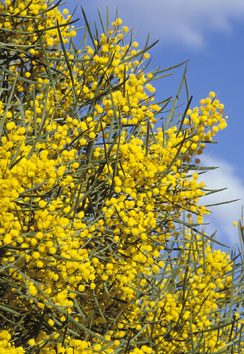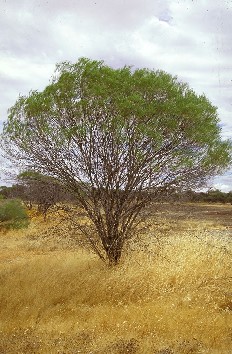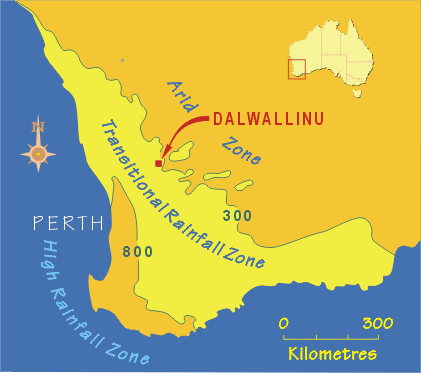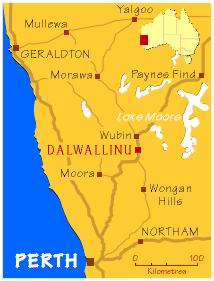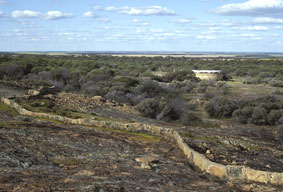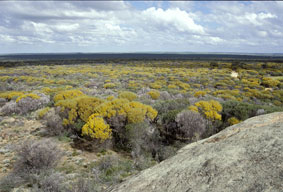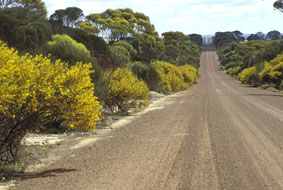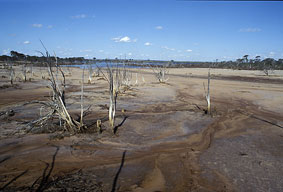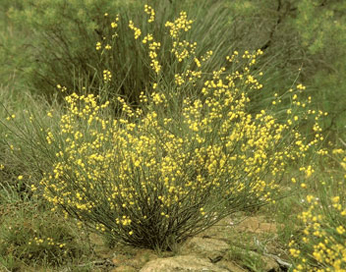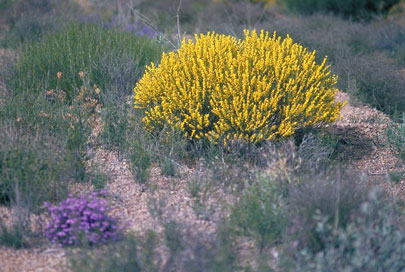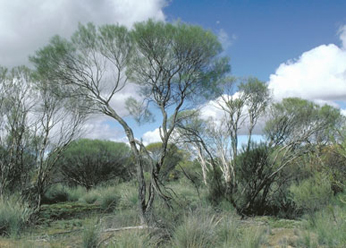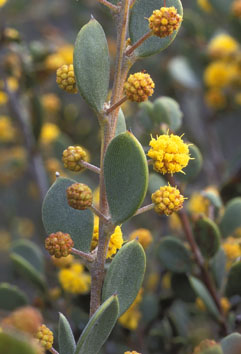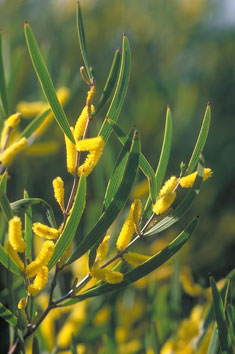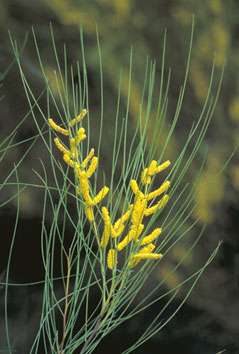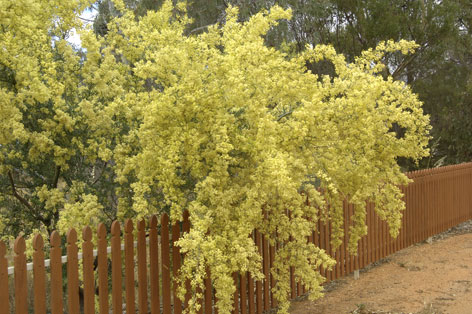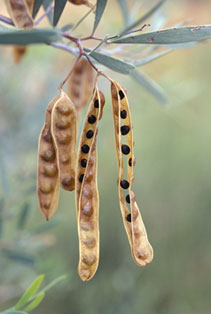By Bruce Maslin
|
|
|
Wattles ( Acacia species) are the largest group of woody plants in Australia with almost 1 000 species currently recognized. They dominate vast areas of the continent and are particularly common in arid and semi-arid regions, with the area of greatest species richness occurring in the wheatbelt of southwest Western Australia . A discussion of the Australian patterns of species richness for Acacia is provided elsewhere on WorldWideWattle.
The Shire of Dalwallinu is located in the central wheatbelt region of Western Australia, about 250 km due northeast of Perth. In botanical terms is strategically placed within the Transitional Rainfall Zone (Hopper 1979) near the boundary of the world renowned botanical 'hotspot', the South West Botanical Province, and the vast Arid Zone that stretches across the continent into eastern Australia.
|
|
|
The highest concentration of Acacia species anywhere in the world occurs in the wheatbelt region of southwest Western Australia (Hnatiuk & Maslin 1988), and Dalwallinu is located within this great centre of diversity. Acacia is the dominant woody landcover plant in many parts of the Shire, particularly in the east. One measure of the abundance of Wattles within the region is that within a 100 km radius Dalwallinu township one can find about 185 species of Acacia. This represents nearly the same number as occurs in North and South America combined, or the entire continent of Africa.
The environment
The Dalwallinu Shire landscape is typical of much of the wheatbelt. It comprises gently undulating country with broad valley floors, occasional well-defined creek lines, many salt lakes (the remnants of ancient drainage systems) and some granite outcrops. Like elsewhere in the wheatbelt the Dalwallinu region is edaphically very complex, which in part contributes to the high botanical diversity of the region. Many species distributions are determined by the soil types upon which they grow, and these soils vary in physical and chemical characteristics depending, to a large extent, upon their position in the landscape. For example, soils low in the landscape are usually colluvial earths of red or brown sandy loam over sandy clay, while higher in the landscape the soils are commonly lighter in both texture and colour, comprising sands or/or gravels. Details of the most soil types found in Shire are provided in the Wattles of the Kalannie Region (Maslin 1998).

Stylized cross-section of a 'typical' landscape in the Dalwallinu Shire showing position of Land Management Units.
The Dalwallinu Shire has been extensively cleared for agriculture and as a result it experiences environmental problems such as increasing salinity and water logging due to rising watertables, soil erosion and loss of remnant vegetation. Many species survive only in roadside populations and in small nature reserves. The control of soil salinisation in the wheatbelt is perhaps the most urgent environmental challenge facing the community today and in recent years there has been increasing interest in identifying deep-rooted perennial species which might be suited to ameliorating or reversing this and associated problems of land degradation ( see Bartle et al. 2002 for discussion). Acacia species offer potential for contributing solutions to these environmental problems as discussed in the AcaciaSearch Report (Maslin and McDonald 2004).
|
|
|
|
|
The species
Around 80 different types of Wattle occur in the Dalwallinu Shire and from the species list link above you gain access to a botanical profile, illustration and photographs for most of them. Included on this list are a number of taxa whose status is uncertain and which require further study to determine if they represent new species. Some of these taxa appear to be rare, for example, A. affin. ancistrophylla , A. affin. multispicata and A . affin. baxteri .
Species variation
The Acacia flora of the Dalwallinu Shire contains representatives from most of the major groups of Wattles that occur in southwestern Australia. While most of the species are low to medium sized shrubs or small trees about 1-5 m tall they do display a wide range of variation in geographic, morphological, biological and ecological characteristics. Some of the morphological variation is easy to see, but for some characters a close examination with a hand lens is needed to see the important features. Simplistically, most of the Dalwallinu Wattles can be accommodated within the following categories:
- Phyllodes flat with one central nerve down the middle; flowers arranged in round heads on peduncles (stalks) that arise directly from within the axil of the phyllodes, or which are arranged in short or long racemes.
- Phyllodes flat with more than one nerve down the middle (commonly very many nerves; these nerves are often difficult to see without the use of a hand lens); flowers arranged either in round heads or elongated spikes (both usually on peduncles that arise directly from within the axil of the phyllodes).
- Phyllodes terete (round in cross-section) or quadrangular, with four to many nerves along their length (nerves difficult to see without the use of a hand lens).
There are of course exceptions to the above, for example, A. restiacea which does not have any phyllodes at all. However, the majority of species can be grouped according to the above phyllode and flower characters. In the Kalannie key (see below) aids are provided to help users understand and correctly interpret the characters that are important in order to make an accurate identifications.
|
|
|
|
|
Dalwallinu Wattles contain a mix of widespread, common species to those which have very restricted distributions in specific habitats. Acacia acuminata (comprising both the narrow phyllode variant and the small seed variant) is the most common species in the Shire but others such as A. anthochaera, A. coolgardiensis subsp. coolgardiensis, A. daphnifolia (syn. A. microbotrya var. borealis), A. neurophylla subsp. erugata, A. resinimarginea, and others, a locally abundant in the places where they occur and they often form dense roadside populations. All the above species are common elsewhere in the wheatbelt region. The distribution of most species is determined by soil type and other habitat characteristics, for example, A. eremaea and A. inceana subsp. conformis & subsp. latifolia (around salt lakes), A. graniticola, A. lasiocalyx and A. synoria (confined to granite rocks), A. resinimarginea (common on deep Wodjil sands), A. neurophylla subsp. erugata (forms dense populations on gravelly rises), A. aff. resinosa (a rare species found only on the uncommon Spillway sands that occur at the break of slopes in the transition zone between sandplain slope and colluvial flats).
A number of widespread species reach their limit of distribution in the Shire, namely, A. coolgardiensis subsp. effusa, A. ligulata, A. merrallii, A. murrayana, A. aff. quadrimarginea, A. ramulosa var. ramulosa and A. victoriae. With the exception of A. merrallii which is common within the South West Botanical Provence, these species predominated in the Arid Zone. Furthermore, the Shire contains outlier populations of species whose distributions are centered elsewhere in the southwest, namely, A. deficiens, A. densiflora, A. dissona var. indoloria and A. eremophila var. variabilis. These species are uncommon in the Shire.
|
|
|
|
Conservation taxa
There are a number of species that are rare and known only from the Shire or its immediate surrounds, namely, A. affin. ancistrophylla, A . affin. baxter, A. inceana subsp. latifolia, A . affin. multispicata, A. affin. resinosa, A. affin. rigens and A. stanleyi . These species are of considerable conservation significance and are all classified as Priority 1 species on the Department of Conservation and Land Management's Declared Rare and Priority Flora List. (Priority One taxa are those which are considered poorly known and which occur in one or a few, generally less than five, populations which are under threat.) Most of the Dalwallinu Priority 1 taxa require further study in order to assess their taxonomic status.
Potential economic species
In recent years there has been considerable attention given to finding native woody perennial species for widescale commercial planting in the wheatbelt as a treatment for salinity control (see Bartle et al. 2002) for overview in relation to Western Australia . At present there are no industries based on Acacia species but the genus is under investigation with A. saligna being identified in the AcaciaSearch Report (Maslin and McDonald 2004) as one of the most promising for the production of woody biomass (and possibly fodder). Although A. saligna is not common in the Shire the four main variants recognized within this species are being trialled by CALM near Dalwallinu to assess their growth performance in this harsh environment.
The use of Acacia seed for human consumption is currently used in Australia in a small way in the 'bush tucker' industry with A. victoriae being the 'industry standard'. Natural stands of this species are rare in the Shire but it grows well in roadside and other amenity plantings in the region. As documented in Edible Wattle Seeds of Southern Australia (Maslin et al. (1998) there are nine species in the Dalwallinu Shire that are considered as having characteristics suitable for on-farm planting for edible seed, namely, A. anthochaera, A. brumalis, A. daphnifolia (syn. A. microbotrya var. borealis ), A. hemiteles, A. jennerae, A. murrayana, A. prainii, A. subrigida and A. victoriae. Further information on the use of Acacia seed as a human food is provided elsewhere on WorldWideWatttle.
|
|
|
Key to species
Most of the Acacia species that occur in the Dalwallinu Shire may be identified by using the electronic key, WATTLES of the Kalannie region: their identification, characteristics and utilisation . This key is a powerful interactive multi-access tool enabling quick, accurate naming of the species and then access to relevant information on their morphology (complemented by photographs and illustrations), biology, ecology, distribution (including maps), silviculture, utilisation and revegetation potential. The main purpose of this key is to facilitate the use of Acacia in landscape amelioration and nature conservation programs within the region.
There are only four taxa of Acacia recorded for the Dalwallinu Shire that are not included in the key, namely, A. aestivalis (forms scattered roadside clumps, mainly south and west of Dalwallinu township) , A. glutinosissima (single small population along highway south of Wubin) , A. hopperiana (known only from Buntine Rock) and A. lineolata subsp. lineolata (known only from salt lakes west of Wubin). Descriptions, illustrations and photographs of these taxa (and all others from the Shire) may be obtained from visiting the WorldWideWattle Species Gallery .
Details on how to obtain a copy of the Kalannie key , which is available on CD, is provided elsewhere on WorldWideWattle.
Floral calender
Given the great diversity of Wattles in the Dalwallinu Shire it would be possible to undertake amenity and other special-purpose plantings to attain flowering for most months of the year, but particularly from April to October. The following table lists selected species that occur naturally within the Shire that would be amenable to such plantings. It should be noted, however, that these species will vary considerably with respect to their growth rate and longevity; these characteristics are not know for many species and can only be accurately determined within given situations by trial and error.
Month |
Species |
Growth characters/soil preferences |
Comments |
April - June (?July) |
Open, +/- spindly shrub 2-3 m; red stems. Sandy brown loam/clay. |
Showy and fragrant flowers; suckers (self perpetuating); forms localized colonies. |
|
April - May |
(syn. microbotrya var. borealis) |
Shrubby small tree mostly 2-4 m (crowns 2-5 m across). Red/brown sandy loam. |
Showy in flower; good for amenity planting and revegetation projects. |
April - May (and other months) |
Bushy when young, matures to tree c. 7 m. Granite; sandy loam. |
An adaptable species that may flower at any time of year (will need to check from experience). |
|
June - July |
Prickly, much-branched low shrub 1-1.5 m tall. Brown loam and clay/loam; granite rocks. |
Useful as a low, showy "fill in" species; provides good nesting site for birds. |
|
June - July |
Low compact shrub, 0.5-1.5 x 1-2. Loam or clay |
Showy flowers and an attractive growth form; plant in clumps; A. ancistrophylla is similar. |
|
June - July (peak at end of June) |
Harsh, prickly shrub 0.5-1.5. Sand or gravelly sand. |
Unusual phyllode shape; endemic to Wubin area. |
|
July - Aug. |
Shrub 1-3 x 1-4 m, tree 4 m. Granite rocks; sand. |
Superfically similar to A. coolgardiensis. |
|
July - Aug. (sometimes into Sept.) |
Tall bushy shrub, 2-3.5 m. Granite rocks. |
Interesting on account of rarity and persistent, orange intermediate phyllodes. |
|
July - Sept. |
Spreading shrub or small tree, 2-4(-5) x 2-5. Gravel and sandy gravel. |
Showy in flower; hardy plant; excellent "ground cover"; good for revegetation projects. |
|
July - Sept. |
Bushy rounded shrub 2-3 x 3-4 m. Light coarse-textured soil including granite rocks and laterite. |
Plumose phyllode tips attractive. |
|
July - Sept. |
|
See A. ramulosa. |
|
July (late) - Sept. (early) |
Tall shrub/small tree, 2-4(-5) m. Red earth. |
See A. ramulosa. |
|
July - Sept. (peak in mid Aug.) |
|
Tall shrub or small tree, 2-5(-6) m tall. Loam and sandy clay. |
A common species; two variants occur in Shire, the narrow phyllode and small seed variants; good for revegetation projects. |
Aug. |
Low shrub. Granite rocks; various soils. |
Interesting growth form - "leafless"; showy in flower. |
|
Aug. - Oct (peak Sept.) |
Tall dense shrub, 1.5-3(-5) x 1.5-4 (-5) m. Brown loam. |
Very attractive and showy in flower; good for revegetation projects. |
|
Aug. - Sept. |
Tall shrub or small tree, 2-5 m. Granite rocks (brown loam). |
Interesting in having very long phyllodes and showy flowers. |
|
Aug. - Sept. |
Low, dense shrub, 0.4-1 x 0.6-3 m. Gravelly sand. |
Very showy and attractive when in flower; good "ground cover". |
|
Aug. - Sept. |
Tall shrub (2-3) growing to small tree (4-5 m). Saline loam. |
Not high priority but useful as a salt-tolerant plant; good for revegetation projects. |
|
Aug. - Sept. |
Usually low-spreading shrub 1-3(-4) x 1.5-4. Brown loamy clay. |
Showy in flower; a hardy species. |
|
Aug. - Sept. |
Open sticky shrubs. Gravelly yellow sand. |
Rare species; unusual growth form. |
|
Aug. - Sept. |
Low compact shrub, 1.5-2 x 2-4 m. Stony or red/brown earth. |
Showy plant with attractive growth form; plant in clumps; A. mackeyana similar. |
|
Aug. - Sept. (?Oct.) |
Bushy shrubs 2-4 m, aging to tree 7-8 m. Red earth. |
Showy when in flower; flowers from an early age; salt tolerant; shire emblem. |
|
Aug. - Sept. (?Oct.) |
Dense round shrubs mostly 1-2 x 1-4 m. Yellow gravelly sand. |
Not high priority but rather showy in flower. |
|
Aug. - Sept. |
Low, wide- spreading, domed or flat-topped shrub 0.5-1.5 x 1-4 m. Heavy brown loam. |
Good ground cover; showy when in flower; seeds with bright orange aril. |
|
Aug. - Sept. |
Compact low shrub, 1-3 x 1-3 m. Red/brown sand or loam over clay. |
Very showy; good to "cluster" plantings to show off flowering. |
|
Aug. - Sept. |
Shrub 1-2 m tall. Yellow sand. |
Flowers bright yellow, lighter coloured than most in region. |
|
Aug. - Sept. |
Shrub or small tree, 2-4(-7) m. Coarse textured gravelly sand. |
Showy plant; very common in region; plant near A. hopperiana; good for revegetation projects. |
|
Aug. - Sept. |
Shrub 1-3 m. Granite rocks. |
Good for granite rock garden. |
|
Aug. - Oct. (peak Sept.) |
Dense, shrubs or small trees mostly 1.5-3 m tall and spreading 2-5 m across. Sand in slightly saline areas. |
A hardy shrub; showy when in flower; good revegetation potential. |
|
Sept. - Oct. |
Shrub or tree. Various |
Useful to include because of multipurpose utilisation. |
|
Sept. - Oct. (peak in mid-Oct.) |
Mostly shrubs 1.5-4 m. Yellow sand or gravelly sand.. |
Showy in flower; late flowering. |
|
Sept. - Oct. |
Rounded shrub 1-3 m. Gravelly yellow sand and loam. |
Not high priority but may be useful; rather showy and easy to grow. |
|
Sept. (?Oct.) |
Shrub or small tree, 2-4(-6) m. Gravelly yellow sand. |
Not high priority but may be useful; rather showy. |
|
Sept. - Oct. |
Tree 4-7 m. Deep yellow (Wodjil) sands. |
Good tall screen species; nice straight trunks; good for revegetation projects. |
|
Sept. - Oct. |
Prickly shrub or small tree, mostly 2-5 m tall; phyllodes clustered. Range of different soil types |
Good for 'live fence' and wildlife refugia. |
|
Oct - Dec. |
Shrub 2-4 m, aging to tree 5 m. Granite; sandy loam |
Interesting on account of rarity; flowers from an early age (when plants are c. 1 m tall). |
|
Oct. (peak) |
Straggly shrub or small tree, 2-5 m. Red/brown loam. |
Showy pale flowers; flowers from an early age; salt tolerant; fast growth rate. Important human food species. |
|
Oct. (peak) |
Tall shrub or small tree, 2-5(-8) m tall. Red/brown loam. |
Showy in flower; flowers from an early age; can sucker; fast growth rate. Good human food species. |
|
Sporadic (probably depends on seasonal conditions) |
Tall shrub/small tree. Red earth. |
" Parkland " plantings with A. burkittii, A. coolgardiensis subsp. effusa & Everlastings (Arid Zone). Slow growing. |
|
Sporadic; most months |
Dense, domed shrub, 1-3(-4) x 2-4 m. Brown loam in low lying areas. |
Useful as a "fill in plant"; not especially showy when in flower. |
|
Sporadic; most months |
Domed large shrub or small tree, 2-5 m tall. Granite; sandy loam. |
Useful as a "fill in plant"; not especially showy. |
|
Sporadic; most months; peak flowering +/- April |
1.5-2.5 x 1-3 m. Light; sandy gravel. |
Useful for all-year flowering. |
Dalwallinu's commitment to Acacia
For almost a decade the Shire of Dalwallinu has actively promoted Acacia s and supported research into this genus. Apart from co-sponsoring the WorldWideWattle website the Shire hosted (in 2001) an Acacia Symposium that explored the conservation and utilisation potential of the Australian dryland species of Acacia , conduct annual Wattle Week festivities each spring, has adopted a species of Acacia (A. anthochaera, Kimberly's Wattle) as their floral emblem along with wheat, and is currently exploring possibilities for constructing an Environmental Center in the town.
References
Bartle, J.R., Olsen, G., Carslake, J. and Cooper, D. (2002). Acacia species as large-scale crops in the Western Australian wheatbelt. Conservation Science Western Australia 4(3): 96-108. This paper is available on the web .
Hnatiuk, R.J. and Maslin, B.R. (1988). Phytogeography of Acacia in Australia in relation to climate and species-richness. Australian Journal of Botany 36: 361-383.
Hopper, S.D. (1979). Biogeographical aspects of speciation in the southwest Australian flora. Annual Review of Ecology and Systematics 10: 399-422.
Maslin, B.R. (1998). Wattle of the Kalannie region: their identification, characteristics and utilisation [CDROM]. Perth : Kalannie Land Care District by Dept. Conservation and Land Management.
Maslin, B.R. and McDonald, M.W. (2004). AcaciaSearch: Evaluation of Acacia as a woody crop option for southern Australia . pp. 267. (Rural Industries Research and Development Corporation: Canberra.)
Maslin, B.R., Thomson, L.A.J., McDonald, M.W. and Hamilton-Brown, S. (1998). Edible wattle seeds of southern Australia . A review of species for use in semi-arid regions . 108 pp. (CSIRO: Australia.). (Available for purchase from CSIRO Publishing.)
